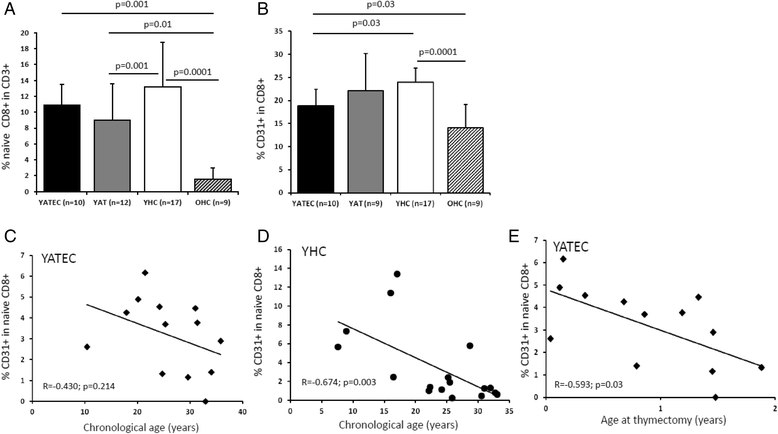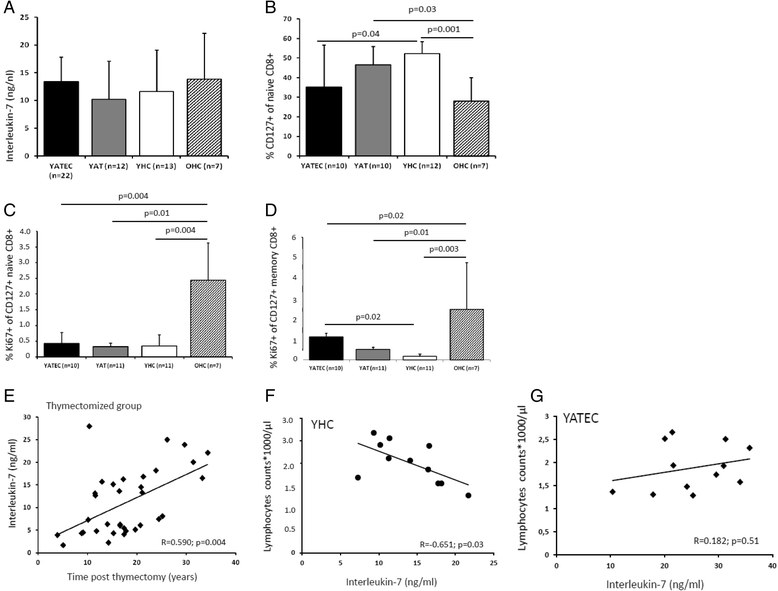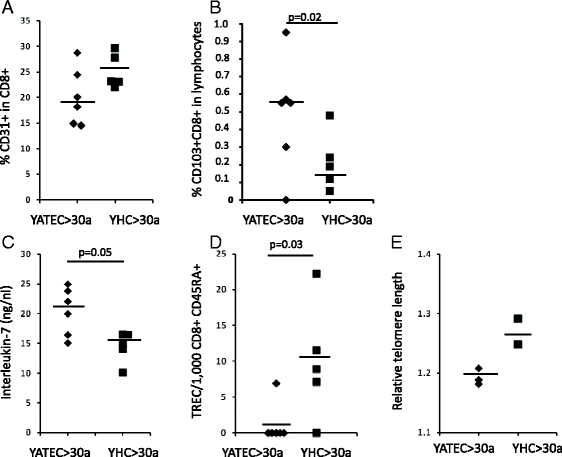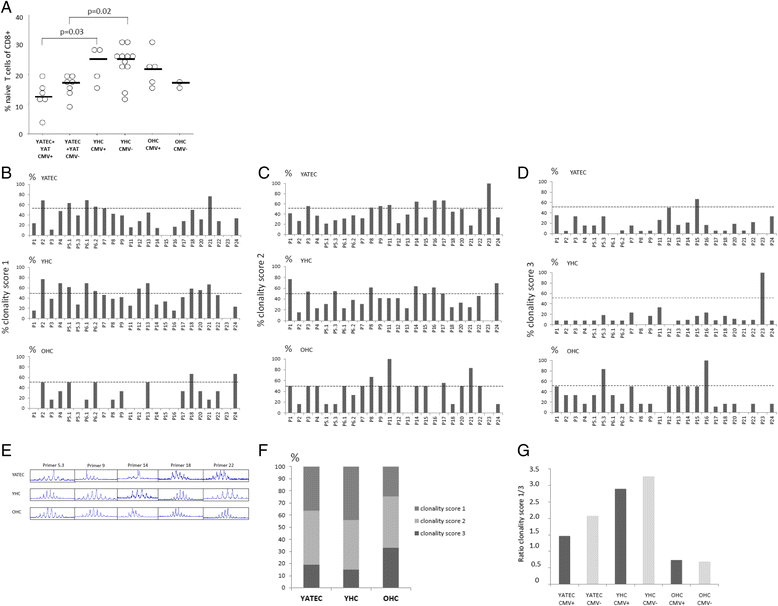Efforts of the human immune system to maintain the peripheral CD8+ T cell compartment after childhood thymectomy
- PMID: 26839574
- PMCID: PMC4736487
- DOI: 10.1186/s12979-016-0058-z
Efforts of the human immune system to maintain the peripheral CD8+ T cell compartment after childhood thymectomy
Abstract
Background: Homeostatic mechanisms to maintain the T cell compartment diversity indicate an ongoing process of thymic activity and peripheral T cell renewal during human life. These processes are expected to be accelerated after childhood thymectomy and by the influence of cytomegalovirus (CMV) inducing a prematurely aged immune system. The study aimed to investigate proportional changes and replicative history of CD8+ T cells, of recent thymic emigrants (RTEs) and CD103+ T cells (mostly gut-experienced) and the role of Interleukin-(IL)-7 and IL-7 receptor (CD127)-expressing T cells in thymectomized patients compared to young and old healthy controls.
Results: Decreased proportions of naive and CD31 + CD8+ T cells were demonstrated after thymectomy, with higher proliferative activity of CD127-expressing T cells and significantly shorter relative telomere lengths (RTLs) and lower T cell receptor excision circles (TRECs). Increased circulating CD103+ T cells and a skewed T cell receptor (TCR) repertoire were found after thymectomy similar to elderly persons. Naive T cells were influenced by age at thymectomy and further decreased by CMV.
Conclusions: After childhood thymectomy, the immune system demonstrated constant efforts of the peripheral CD8+ T cell compartment to maintain homeostasis. Supposedly it tries to fill the void of RTEs by peripheral T cell proliferation, by at least partly IL-7-mediated mechanisms and by proportional increase of circulating CD103+ T cells, reminiscent of immune aging in elderly. Although other findings were less significant compared to healthy elderly, early thymectomy demonstrated immunological alterations of CD8+ T cells which mimic features of premature immunosenescence in humans.
Keywords: CD8; CMV; Naive T cells; TCR diversity; TRECs; Telomeres; Thymectomy.
Figures






Similar articles
-
Thymectomy in early childhood: a model for premature T cell immunosenescence?Rejuvenation Res. 2009 Aug;12(4):249-58. doi: 10.1089/rej.2009.0864. Rejuvenation Res. 2009. PMID: 19673593 Review.
-
Thymectomy in early childhood: significant alterations of the CD4(+)CD45RA(+)CD62L(+) T cell compartment in later life.Clin Immunol. 2009 Feb;130(2):123-32. doi: 10.1016/j.clim.2008.08.023. Epub 2008 Oct 31. Clin Immunol. 2009. PMID: 18977182
-
Thymectomy in Juvenile Myasthenia Gravis Is Safe Regarding Long Term Immunological Effects.Front Neurol. 2021 Feb 25;12:596859. doi: 10.3389/fneur.2021.596859. eCollection 2021. Front Neurol. 2021. PMID: 33716918 Free PMC article.
-
Long-term restoration of the human T-cell compartment after thymectomy during infancy: a role for thymic regeneration?Blood. 2011 Jul 21;118(3):627-34. doi: 10.1182/blood-2011-03-341396. Epub 2011 May 31. Blood. 2011. PMID: 21628415
-
Early Thymectomy Is Associated With Long-Term Impairment of the Immune System: A Systematic Review.Front Immunol. 2021 Nov 25;12:774780. doi: 10.3389/fimmu.2021.774780. eCollection 2021. Front Immunol. 2021. PMID: 34899730 Free PMC article.
Cited by
-
The immune system in infants: Relevance to xenotransplantation.Pediatr Transplant. 2020 Nov;24(7):e13795. doi: 10.1111/petr.13795. Epub 2020 Aug 26. Pediatr Transplant. 2020. PMID: 32845539 Free PMC article. Review.
-
Clinical characteristics of myasthenia gravis (MG) patients developing other autoimmune diseases after thymectomy from one single center cohort.Thorac Cancer. 2023 Jan;14(2):135-142. doi: 10.1111/1759-7714.14723. Epub 2022 Nov 23. Thorac Cancer. 2023. PMID: 36419347 Free PMC article.
-
The significance of neonatal thymectomy for shaping the immune system in children with congenital heart defects.Kardiochir Torakochirurgia Pol. 2017 Dec;14(4):258-262. doi: 10.5114/kitp.2017.72231. Epub 2017 Dec 20. Kardiochir Torakochirurgia Pol. 2017. PMID: 29354179 Free PMC article. Review.
-
Functional recreation of age-related CD8 T cells in young mice identifies drivers of aging- and human-specific tissue pathology.Mech Ageing Dev. 2020 Oct;191:111351. doi: 10.1016/j.mad.2020.111351. Epub 2020 Sep 8. Mech Ageing Dev. 2020. PMID: 32910956 Free PMC article.
-
Human neonatal thymectomy induces altered B-cell responses and autoreactivity.Eur J Immunol. 2017 Nov;47(11):1970-1981. doi: 10.1002/eji.201746971. Epub 2017 Sep 6. Eur J Immunol. 2017. PMID: 28691750 Free PMC article.
References
LinkOut - more resources
Full Text Sources
Other Literature Sources
Research Materials

